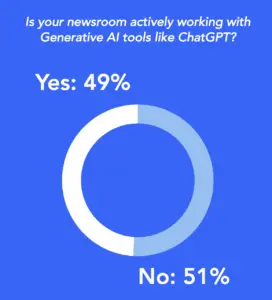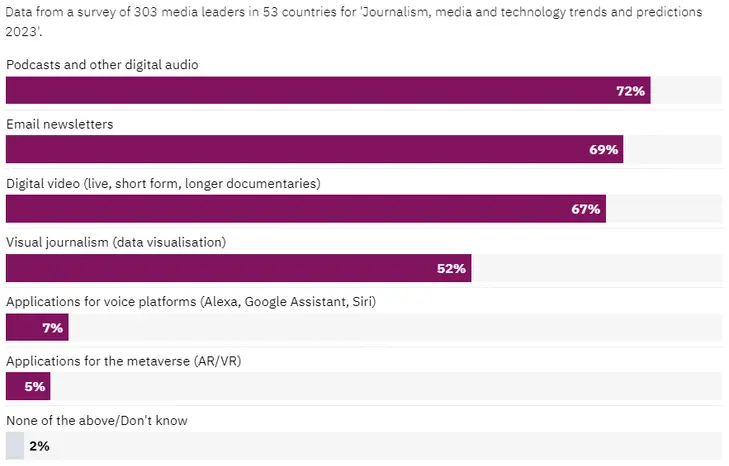Digital publishing has revolutionized information sharing, granting us unparalleled access to content across diverse platforms. Now, with the emergence of artificial intelligence (AI), digital publishing is soaring to new heights. AI is not only transforming how content is created and distributed but also improving the reader’s experience. This fusion of AI and digital publishing has ushered in a new era of innovation, where AI and machine learning algorithms play a central role in content creation, curation, and personalization.
This blog explores the fascinating connection between AI and digital publishing. We'll look into how AI and machine learning are changing the way content is created, selected, and customized. Before we dive in, let us take a look at the market. Tech giants like Amazon, Google, and Apple dominate the digital publishing landscape, providing platforms for authors, publishers, and content creators to distribute their works. According to WordsRated's research, Amazon's Kindle reigns supreme in the U.S. ebook market, capturing a staggering 83% market share in 2021.
Let’s come along with this journey as we are going to uncover how AI is changing the field of digital publishing, giving us the opportunity to better grasp how it affects the content creation process and the experience for readers.
Emergence of AI in Digital Publishing
The rapid advancement of artificial intelligence technologies has publishers leveraging AI to revolutionize various aspects of content creation, distribution, and consumption. This transformation is not only reshaping the way content is produced and consumed but also opening up new opportunities for publishers to innovate and stay competitive in an increasingly digital landscape.
It is noteworthy that almost half (49%) of the participants in the World Association of New Publishers survey said they used tools like ChatGPT in their newsrooms. This demonstrates the gradual dependency of the digital publishing industry on AI tools to streamline and enhance their workflow. In this article, we explore the intersection of AI and digital publishing, delving into the ways AI is reshaping this landscape and revolutionizing the way content is produced, consumed, and interacted with.
One of the key areas where AI is making its mark in digital publishing is content creation. AI-powered tools can analyze vast amounts of data to identify trends, predict audience preferences, and generate personalized content tailored to individual readers' interests. This capability enables publishers to produce high-quality, relevant content on a large scale, reducing the time and resources traditionally required for content creation.
Moreover, AI algorithms can optimize content for search engines and social media platforms, increasing visibility and engagement. By analyzing user behavior and feedback, AI can also help publishers refine their content strategies, ensuring they deliver content that resonates with their target audience.
AI in Action: How is it Transforming Digital Publishing?
AI is shaking up the world of digital publishing, as we saw above. But how exactly is this happening? Let's dive into some AI applications that showcase its power in action:
Content Creation and Curation:
AI-powered tools like GPT-3, Gemini, Jasper, Claude, and Writesonic can generate high-quality content, such as articles, summaries, and product descriptions, based on given prompts. This streamlines the content creation process and reduces the time and effort required by human writers.
AI algorithms analyze user behavior and preferences to provide personalized content recommendations. Platforms like Netflix, Spotify, and Amazon use AI to suggest relevant movies, music, and books to users, enhancing their overall experience.
Data-driven Insights:
AI helps publishers gain insights into audience behavior, preferences, and demographics by analyzing large volumes of data. These insights enable publishers to use content strategies and offerings to better meet audience needs.
AI algorithms can forecast trends in content consumption and engagement, enabling publishers to anticipate demand and optimize their content accordingly. Some of the AI tools for data driven insights include Databricks, Tableau, Power BI, etc.
Enhanced User Experience:
Publishers use AI-powered chatbots and virtual assistants such as Amazon Alexa, Siri, Google Assistant, and Bixby to provide instant support and engage with users in real-time. These bots can answer queries, recommend content, and assist users in navigating through digital platforms.
NLP techniques enable publishers to improve search functionality, sentiment analysis, and content summarization, enhancing the overall user experience.
Content Optimization:
AI tools such as Frase.io, Diib, Alli AI, Surfer, and Keyword Insights assist publishers in optimizing content for search engines by analyzing keywords, trends, and user intent. This helps improve visibility and drive organic traffic to digital publications.
AI algorithms facilitate A/B testing of content elements, such as headlines, images, and calls-to-action, to determine which variations resonate best with the audience and drive higher engagement.
Automated Publishing Workflows:
Quintype, Sanity, and Wordpress are some of the AI-powered CMS platforms that automate various aspects of the publishing process, including content scheduling, formatting, and distribution. This streamlines workflow efficiency and reduces manual intervention.
AI-driven translation services enable publishers to localize content for global audiences quickly and accurately, breaking down language barriers and expanding their reach.
Monetization Strategies:
AI algorithms, including supervised learning, unsupervised learning, and reinforcement learning, help publishers optimize pricing strategies by analyzing market trends, demand elasticity, and user behavior. This enables dynamic pricing models that maximize revenue while remaining competitive.
AI-powered ad targeting solutions deliver personalized ads to users based on their interests, demographics, and online behavior, increasing ad relevance and effectiveness. Some of the AI tools that assist in monetization strategies are Google AdSense, Taboola, Amazon Personalize, etc.
Benefits: How is AI Empowering the Publishing Industry
As we have been reading above, AI is rapidly transforming the publishing industry, offering a wealth of advantages for publishers, authors, and readers alike. Let's explore some of the key benefits:
1. Recommendation Engine
AI employs machine learning algorithms to analyze user reading behaviors and preferences, enabling the suggestion of the articles that are best suited to their interests. By understanding users' content consumption patterns, publishers can enhance engagement and retention by presenting them with relevant material.
The recommendation system utilizes collaborative filtering or content-based filtering methods to personalize suggestions, ensuring that each user receives content aligned with their tastes. The continuous refining of recommendation algorithms through user feedback and interaction data, ensures accurate suggestions.
2. Automated Content Tagging and Metadata Generation
The focus of AI lies in developing algorithms capable of automatically assessing and categorizing content according to its topic, theme, and relevance. This process extends to generating metadata encompassing keywords, descriptions, and categories, all aimed at enhancing searchability and bolstering SEO performance.
By integrating advanced natural language processing (NLP) techniques, publishers can easily extract valuable insights from text data, ensuring that content is organized and navigable with precision. Ultimately, these efforts lead to an improved user experience and heightened content discoverability, enabling users to find relevant information effortlessly.
3. Content Summarization
Publishers can deploy AI-powered algorithms designed to extract pivotal insights and condense lengthy articles effectively. Through techniques like text summarization, abstraction, and extraction, you can craft concise summaries that encapsulate the essence of the content.
This approach not only enhances readability and comprehension, particularly for users with time constraints or limited attention spans, but also facilitates a quick grasp of the main points of an article, empowering users to make informed decisions about further reading.
4. Audience Analytics and Insights
By using advanced analytics and AI, Publishers can get actionable insights into audience behavior, preferences, and trends, enabling in making data-driven decisions that optimize content strategy and enhance the user experience.
Drawbacks: Challenges of AI in Digital Publishing
AI does create a rosy picture of exciting opportunities, but we also need to acknowledge the potential challenges that follow its implementation. Let us understand what the drawbacks of AI are:
1. Over-Reliance on AI
While AI algorithms can automate various tasks, such as content recommendation and tagging, over-reliance on these algorithms may lead to a lack of human oversight. This can result in inaccuracies or biases in content curation, potentially alienating users or affecting content quality.
2. Ethical Concerns and Bias
AI systems are susceptible to biases present in the data they're trained on, potentially perpetuating stereotypes or excluding certain demographics. In the publishing industry, this could lead to biased content recommendations or limited representation of diverse voices, which may undermine inclusivity and credibility.
3. Quality vs. Quantity Trade-off
While AI can automate content creation and curation processes, there's a risk of prioritizing quantity over quality. Automated content generation may result in generic or low-quality material, diminishing the overall value and reputation of the publishing platform.
4. Dependency on Technological Infrastructure
Implementing AI in publishing necessitates robust technological infrastructure and expertise. Smaller publishers or those with limited resources may struggle to adopt and maintain AI systems effectively, widening the gap between larger players and smaller entities in the industry. Moreover, dependency on complex technology may pose challenges during system failures or technical glitches, disrupting operations and the user experience.
2024 and Beyond: AI Trends in Digital Publishing
The integration of AI in digital publishing continues to accelerate, fostering groundbreaking trends and cutting-edge advancements that are shaping the future of the industry. Here are some of the trends that we should look out for in 2024.
Enhanced Experiences Through AR/VR Integration
AR/VR technologies allow publishers to present data and information in more visually engaging and comprehensible ways. Complex datasets can be transformed into interactive 3D visualizations, enabling readers to explore and understand information from multiple perspectives. AI algorithms can assist in data analysis, uncovering insights and patterns that might not be immediately apparent to the human eye.
According to a report by the Reuters Institute for the Study of Journalism, just 5% of publishers are currently directing investments toward AR/VR technologies, while the majority are focusing resources on digital audio formats such as podcasts (72%), email newsletters (69%), and video content (67%). This presents an exclusive chance to take the lead in a burgeoning trend expected to gain even more attention in the future.
Revolutionizing Search with Voice Technology
As per Demandsage, currently there are more than 4.2 billion voice assistant devices, and projections suggest this figure will double to 8.4 billion by 2024. As the use of voice search and digital assistants continues to surge, publishers must enhance their SEO strategies to utilize voice search optimization (VSO).
Incorporating long-tail keywords and adopting a conversational tone in content aimed at addressing specific inquiries can elevate a page's visibility in voice searches. The focus isn't solely on being discovered but on being actively engaged with and heard.
Increased Demand of niche publications
As AI technology continues to evolve and permeate various industries, there's a growing need for specialized knowledge and insights. Niche publications focusing on AI cater to professionals, researchers, and enthusiasts who seek in-depth analysis, updates on the latest developments, and discussions around specialized topics within the field.
AI is no longer confined to traditional tech sectors. It's now applied in diverse fields such as healthcare, finance, agriculture, and the creative industries. Niche publications serve as platforms where professionals from these specialized domains can access AI-related content tailored to their specific interests and requirements.
More Focus on Mobile UX
With the proliferation of smartphones, a significant portion of internet traffic now comes from mobile devices. Publishers must optimize their content and platforms for mobile viewing to cater to the preferences and behaviors of their audience.
Implementing responsive design ensures that content adapts seamlessly to different screen sizes and orientations. Mobile-optimized layouts improve readability, navigation, and the overall user experience on smartphones, enhancing engagement and reducing bounce rates.
Mobile users expect fast loading times. Publishers should optimize images, videos, and other multimedia elements to minimize loading times and ensure a smooth browsing experience. Utilizing techniques like lazy loading in React Native and content caching can further improve performance on mobile devices.
The Next Chapter: Shaping the Future of Digital Publishing
The future scope of AI in digital publishing is poised for significant expansion, promising to revolutionize the industry in numerous ways. AI-driven technologies are already enhancing content creation, curation, and personalization, enabling publishers to produce more engaging and tailored material for their audiences.
Natural Language Processing (NLP) algorithms are improving the efficiency of editing and proofreading processes, reducing errors, and enhancing overall quality. Additionally, AI-powered data analytics tools provide publishers with valuable insights into reader preferences and behaviors, facilitating targeted marketing strategies and content optimization.
As AI continues to advance, we can anticipate further developments in automated content generation, immersive storytelling experiences through virtual and augmented reality, and enhanced user interaction through voice-enabled interfaces. Ultimately, AI stands to reshape the digital publishing landscape, offering unprecedented opportunities for innovation and growth.
Final Thoughts
The integration of AI into digital publishing marks a pivotal moment in the industry's evolution. It's not merely a technological advancement but a shift that empowers publishers to deliver content in more efficient, personalized, and engaging ways. AI streamlines content creation, editing, and distribution processes, allowing publishers to focus on creativity and innovation.
At SoluteLabs, we do not simply observe these trends; rather, we embody and excel in them. Whether you are seeking seamless AI integration for your website or aiming to modernize your technological infrastructure, we cordially invite you to engage with us and actualize your vision into reality.
Frequently Asked Questions
Have a product idea?
Talk to our experts to see how you can turn it
into an engaging, sustainable digital product.








